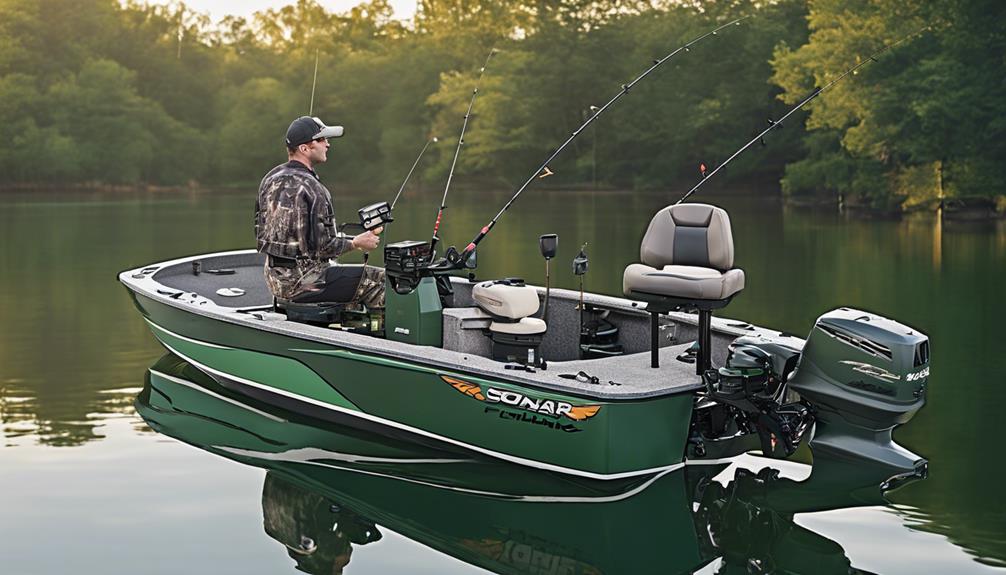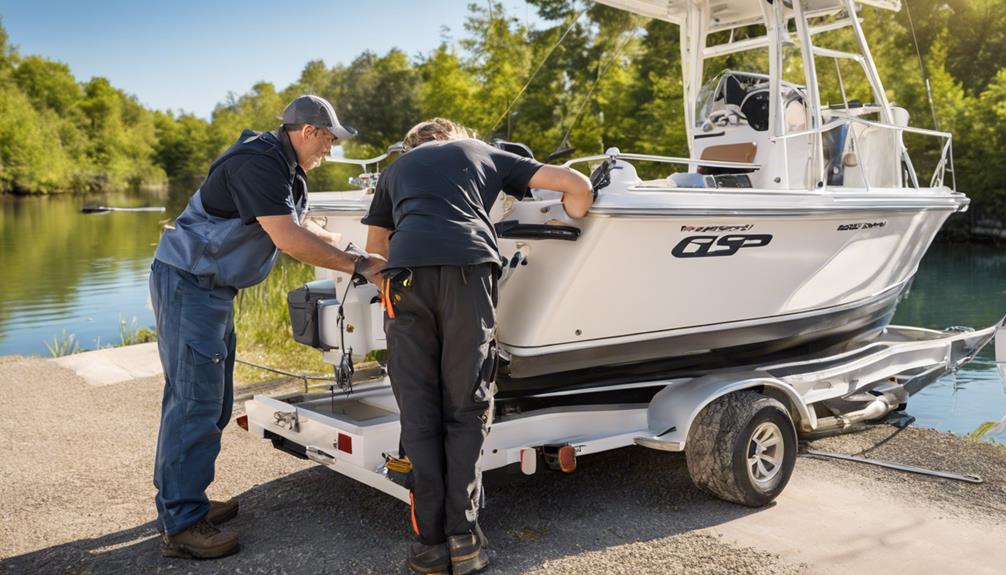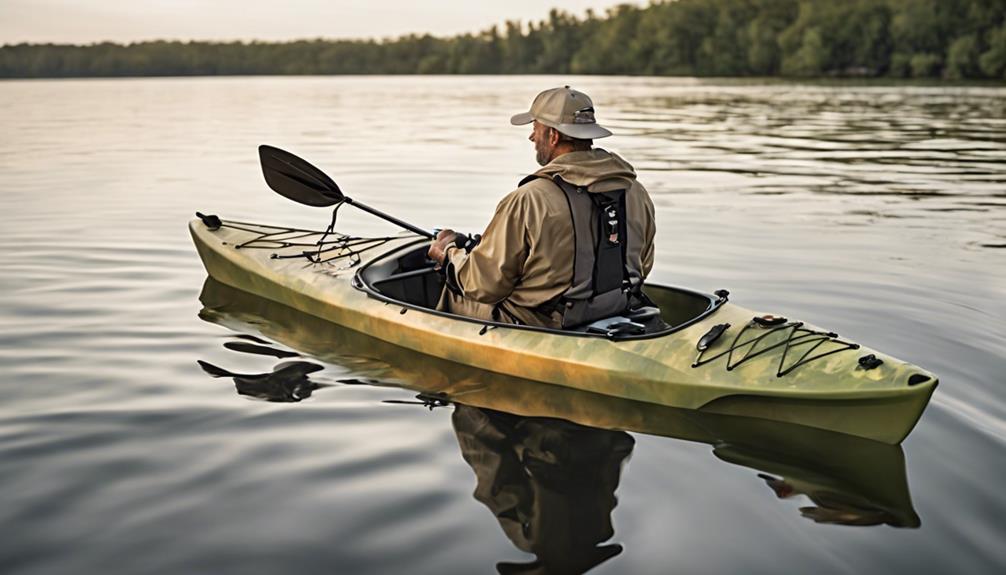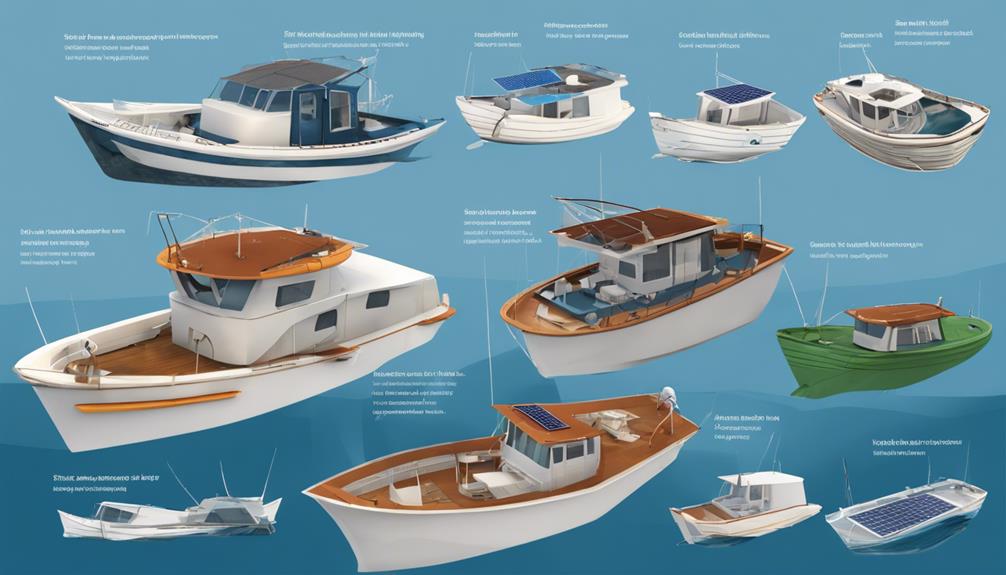When it comes to setting sail for a bass fishing adventure, having the right tools on your boat is like having a well-stocked toolbox for a carpenter – essential for success.
From rod holders to fishfinders, each item plays a crucial role in enhancing your fishing experience. But what exactly are the must-have items that can make all the difference between a good day on the water and a great one?
Let's uncover the key essentials for your bass fishing boat that can elevate your angling game to the next level.
Rod Holders
Make sure your bass fishing boat is equipped with sturdy and adjustable rod holders for a seamless fishing experience. Rod holders are essential for keeping your fishing rods secure and organized while out on the water. When selecting rod holders for your bass fishing boat, consider customized options that cater to your specific needs. Whether you prefer flush-mounted rod holders for a sleek look or adjustable ones for versatility, there are various choices available to enhance your fishing setup.
When installing rod holders on your bass fishing boat, it's crucial to consider placement for easy access and optimal functionality. Position your rod holders within arm's reach to ensure quick rod retrieval when a fish bites. Additionally, mounting rod holders near seating areas can provide convenience during long fishing trips. Before installation, double-check the compatibility of the rod holders with your boat's design to avoid any issues down the line.
To maximize your fishing efficiency, experiment with different rod holder configurations to find what works best for you. Some anglers opt for dual rod holders to manage multiple lines simultaneously, while others prefer single holders for a more straightforward setup. Whichever option you choose, ensure that the rod holders are securely attached to withstand the movements and vibrations of the boat. By incorporating well-chosen and properly installed rod holders, you can elevate your bass fishing experience and increase your chances of a successful catch.
Trolling Motor
Ensure your bass fishing boat is equipped with a reliable trolling motor to enhance your angling experience on the water. When it comes to selecting a trolling motor for your bass fishing boat, consider the following key points:
- Battery Power: Opt for a trolling motor with sufficient battery power to last throughout your fishing trips. Battery power is crucial to ensure you can maneuver your boat efficiently and reach your desired fishing spots without running out of juice.
- Transom Mount: Choose a trolling motor that's transom-mounted for easy installation and maneuverability. Transom-mounted motors are typically easier to operate and control, providing you with a seamless fishing experience.
- Variable Speed Control: Look for a trolling motor that offers variable speed control. This feature allows you to adjust the speed based on your fishing needs, whether you're navigating through rough waters or trying to maintain a steady position while casting your line.
- Durability: Invest in a trolling motor known for its durability and reliability. Bass fishing can put equipment to the test, so having a sturdy trolling motor that can withstand different conditions is essential for a successful fishing trip.
Fishfinder
Enhance your bass fishing experience with a reliable fishfinder on your boat, providing real-time information on underwater structures and fish locations. Fishfinders utilize sonar technology to send sound waves through the water, which bounce off objects and return to the device, displaying a detailed image of what lies beneath the surface. This technology is essential for understanding fish behavior and their whereabouts.
When out on the water, having access to accurate depth readings is crucial for locating fish. A fishfinder can help you identify drop-offs, underwater vegetation, and other structures where bass tend to hide. By understanding the water depth, you can adjust your fishing technique accordingly to increase your chances of a successful catch.
Additionally, fishfinders can provide valuable information on water temperature. Fish are sensitive to temperature changes, and knowing the water temperature can help you predict their movements. During different seasons, bass may prefer specific temperature ranges, so having this data at your fingertips can guide you to the most productive fishing spots.
Livewell System
Navigating the waters of bass fishing, your next essential consideration is the Livewell System onboard your boat. This system is crucial for maintaining the health of the fish you catch, ensuring they stay lively until it's time for release or weigh-in.
Here are some key points to keep in mind regarding your Livewell System:
- Livewell maintenance, fish care: Regularly check and clean your livewell to prevent the buildup of harmful bacteria that could harm your catch. Remove any debris, old bait, or fish remains after each trip. Consider using livewell treatments to keep the water in optimal condition for the fish.
- Livewell aerators, water circulation: Proper oxygenation is vital for the well-being of the fish in your livewell. Invest in a reliable aerator to ensure a constant flow of fresh oxygen into the water. Good water circulation helps distribute oxygen evenly and keeps the water temperature consistent throughout the livewell.
- Monitor water quality: Test the water in your livewell regularly to ensure it meets the necessary conditions for fish survival. Factors such as ammonia levels, pH, and temperature can impact the health of the fish. Make adjustments as needed to maintain a healthy environment for your catch.
- Avoid overcrowding: Overloading your livewell can stress the fish and lead to injuries or even fatalities. Be mindful of the size and number of fish you keep in the livewell to ensure they have enough space to swim and remain healthy until release.
Safety Gear
Investing in essential safety gear is paramount for a successful and secure bass fishing experience on your boat. When out on the water, it's crucial to be prepared for any unexpected situations that may arise. Begin by familiarizing yourself with emergency protocols to ensure a quick and effective response in case of emergencies.
Safety equipment is a fundamental aspect of bass fishing. Personal flotation devices, such as life jackets, are non-negotiable. Make sure you have enough Coast Guard-approved life jackets for every person on board. Additionally, having a throwable flotation device on hand can be a lifesaver in emergencies where someone falls overboard.
First aid supplies are another vital component of safety gear. A well-stocked first aid kit should include items like bandages, antiseptic wipes, adhesive tape, and pain relievers. It's essential to have this kit easily accessible in case of minor injuries or accidents while fishing.
Regularly check and maintain all safety gear to ensure everything is in working order. Conduct safety drills with your passengers so everyone knows what to do in case of an emergency. By prioritizing safety and being well-prepared with the right equipment, you can enjoy your bass fishing adventures with peace of mind.
Anchoring Equipment
When preparing for your bass fishing excursions, ensuring you have the necessary anchoring equipment is essential for maintaining stability and control on the water. To make sure you're well-equipped for anchoring your bass fishing boat effectively, consider the following items:
- Anchor Ropes and Anchor Chains: These are vital components for anchoring your boat securely in place. Anchor ropes provide the necessary length to reach the bottom, while anchor chains add weight to help the anchor set firmly.
- Anchor Winches: These devices make lowering and raising your anchor much easier and quicker. They save you time and effort, especially when you need to reposition your boat multiple times during a fishing session.
- Anchor Locks: Anchor locks are essential for keeping your anchor securely in place once it has been deployed. They prevent the anchor from dislodging unintentionally, providing you with peace of mind while you focus on fishing.
Having reliable anchoring equipment not only ensures your safety on the water but also enhances your overall fishing experience. With anchor ropes, anchor chains, anchor winches, and anchor locks in your arsenal, you can effectively control your boat's position and focus on reeling in those big bass.
Bait and Tackle Storage
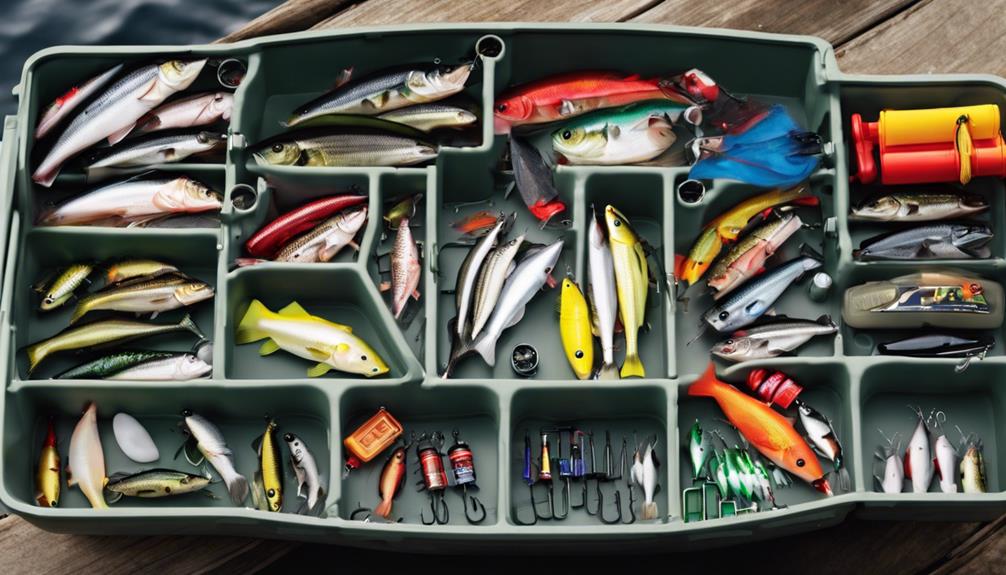
Ensuring your bass fishing boat is well-equipped for anchoring is crucial, now let's shift our focus to the efficient storage of bait and tackle. Tackle organization plays a vital role in keeping your gear protected and easily accessible during your bass fishing trips.
Investing in a tackle box with multiple compartments or trays can help you categorize different types of lures, hooks, weights, and other tackle items. This level of organization not only saves you time on the water but also ensures that your gear remains in top condition.
When it comes to bait preservation and equipment durability, selecting the right storage containers is key. For live bait such as minnows or worms, consider using bait cups or aerated containers to keep them lively throughout your fishing expedition.
Sturdy and waterproof tackle bags or boxes are essential for safeguarding your artificial baits, reels, lines, and other tackle from moisture and damage. Opt for containers made of durable materials like hard plastic or corrosion-resistant metals to prolong the lifespan of your equipment.
Navigation Lights
Are you aware of the importance of having properly functioning navigation lights on your bass fishing boat? These lights are crucial for your safety, especially during night fishing trips. Here are some key points to consider regarding navigation lights:
- Night Fishing: When engaging in night fishing, having working navigation lights isn't just recommended; it's a safety essential. Properly lit navigation lights help you see other boats and aids them in seeing you, preventing potential collisions in the dark.
- Regulations: It's essential to be familiar with the regulations regarding navigation lights for bass fishing boats. Different bodies of water may have specific requirements for when and how your navigation lights should be used. Complying with these regulations ensures you're operating your boat safely and legally.
- Requirements: The requirements for navigation lights typically include having lights that can be seen from a certain distance, specific color combinations for different sides of the boat, and the ability to switch between different lighting configurations as needed.
- Maintenance: Regularly check and maintain your navigation lights to ensure they're in proper working condition. Clean the lights, check for any wiring issues, and replace bulbs promptly to guarantee they function correctly when you need them most.
Frequently Asked Questions
How Should I Properly Maintain and Clean My Rod Holders to Ensure They Stay in Good Condition?
To keep your rod holders in good shape, store them in a dry place away from moisture when not in use.
For cleaning, use a mild soap and water solution with a soft cloth. Avoid harsh chemicals that could damage the material.
Regularly check for any signs of wear or rust. Proper maintenance and cleaning will help ensure your rod holders stay in good condition for your next fishing trip.
What Are Some Common Troubleshooting Tips for a Trolling Motor That Is Not Working Properly?
If your trolling motor isn't working properly, start by checking the connections and ensuring the battery is charged. Consider replacing the battery if needed.
Inspect the propeller for any debris or damage that could be affecting performance. Troubleshooting motor issues can often be resolved by basic maintenance and checking key components.
Regularly maintaining your trolling motor and being prepared for battery replacements can help prevent issues while out on the water.
Are There Any Special Tips for Using a Fishfinder Effectively in Different Types of Water Conditions?
When using a depth finder or sonar in different water conditions, remember that fish behavior and lure selection are key. Adjust the settings based on water clarity and depth. In murky waters, increase sensitivity; in clear waters, decrease it.
Pay attention to fish arches and structure on the screen. Experiment with different lure depths. By fine-tuning your approach, you can effectively utilize your fishfinder for a successful bass fishing trip.
How Often Should I Clean and Maintain My Livewell System to Keep It Functioning Properly?
To keep your livewell system in top shape, clean and maintain it regularly. Aim for cleaning it at least once a month, but adjust based on how frequently you fish.
Proper rod holder care is vital too. Ensure they're securely mounted and regularly check for any signs of wear or damage. Use gentle cleaning techniques to prolong their lifespan and keep them functioning effectively.
What Are Some Important Safety Precautions to Keep in Mind When Using Anchoring Equipment in Different Water Environments?
When anchoring your boat in different water environments, remember essential safety precautions. Proper anchoring techniques and equipment maintenance are crucial. Always check the anchor line for wear and tear, and ensure it's securely attached.
Never anchor in swift currents or near underwater obstacles. Use buoys or markers to signal your anchoring spot. Prioritize safety by understanding your surroundings and having the right gear for a secure anchoring experience.
Conclusion
Overall, ensuring you have the right equipment on your bass fishing boat can make all the difference in having a successful and enjoyable fishing trip.
From rod holders to navigation lights, each item serves a crucial purpose in maximizing your fishing experience.
By having these must-have items on board, you can fish with ease and confidence, knowing you're well-equipped for any situation that may arise on the water.
Happy fishing!
